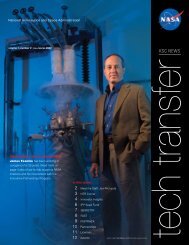2006-2007 - Kennedy Space Center Technology Transfer Office
2006-2007 - Kennedy Space Center Technology Transfer Office
2006-2007 - Kennedy Space Center Technology Transfer Office
- No tags were found...
You also want an ePaper? Increase the reach of your titles
YUMPU automatically turns print PDFs into web optimized ePapers that Google loves.
and commercial launch vehicles. The MGS will provide much higher-fidelity data on thequantities and thermodynamic states of the propellants during launch and flight.Significant progress has been made in this effort. Qualification verification plans have beendeveloped for the Cryo-Tracker® MGS, which consists of the Cryo-Tracker® probe, avionics,and tank feedthrough. The probe has been tested to obtain material property data, includingtensile yield stress, elastic modulus, and thermal expansion coefficients at ambient andcryogenic temperatures. These data are being used in a high-fidelity finite-element analysis onthe probe to determine structural margins and resonance frequencies for worst-case in-tankloads and vibrations.In addition, the MGS electronics box has been redesigned and fabricated for space-vacuumenvironments and will undergo qualification testing for flight environments. A continuoustank-feedthrough (containing no connectors) has been designed and fabricated and has passedextensive leak testing at both ambient and cryogenic temperatures. Operational tests of thefeedthrough design are under way.The project is expected to be completed on schedule, and the technology is expected toadvance significantly in maturity and readiness for use as a propellant measurement system forlaunches and space vehicles.SBIR/STTRKSC’s Innovative Partnership Program also encompasses the Small Business InnovationResearch (SBIR) and Small Business <strong>Technology</strong> <strong>Transfer</strong> (STTR) Programs. SBIR andSTTR play an integral role in fulfilling the missions and objectives of KSC. These programsprovide small, high-tech companies and research institutions opportunities to participate inGovernment-sponsored research and development efforts in key technology areas, enablinginnovations that also have potential commercial applications and thereby contributing to theoverall NASA mission. As small businesses work to meet NASA’s research and developmentneeds, they stimulate growth in local economies and nearby business communities.SuccessesEM Photonics Solver for Image EnhancementThe quality of the images taken with long-range optical systems (more than 1 kilometer)is severely degraded by atmospheric movements in the path between the region underobservation and the imaging system. Fortunately, image-processing algorithms havebeen developed to help compensate for these disturbances. However, these atmosphericcompensation algorithms are computationally intensive, which prevents even top-of-thelinePCs from evaluating them in real time. EM Photonics is building a solver capable ofenhancing long-range imagery in real time.Range surveillance and launch tracking are critical components of space exploration becauseof their implications for safety, cost, and the overall mission timeline. <strong>Space</strong> vehicle launchesare often delayed because of the challenge of verifying that the range is clear, and such delaysare likely to become more prevalent as more and more spaceports are built. To expedite rangeclearance, it is vital to see through the atmosphere. Reduced visibility also makes it hard totrack rockets throughout launch, when atmospheric effects can be even more pronounced.NASA collects massive amounts of long-range imagery for providing prelaunch range safety,132 KSC Innovative Partnership Program













